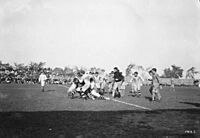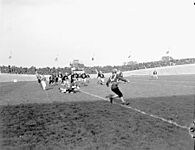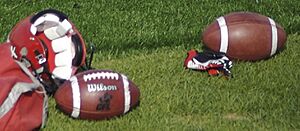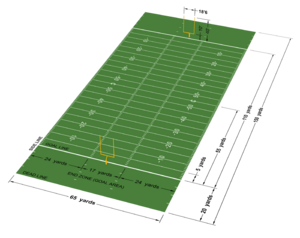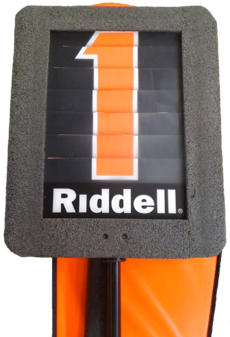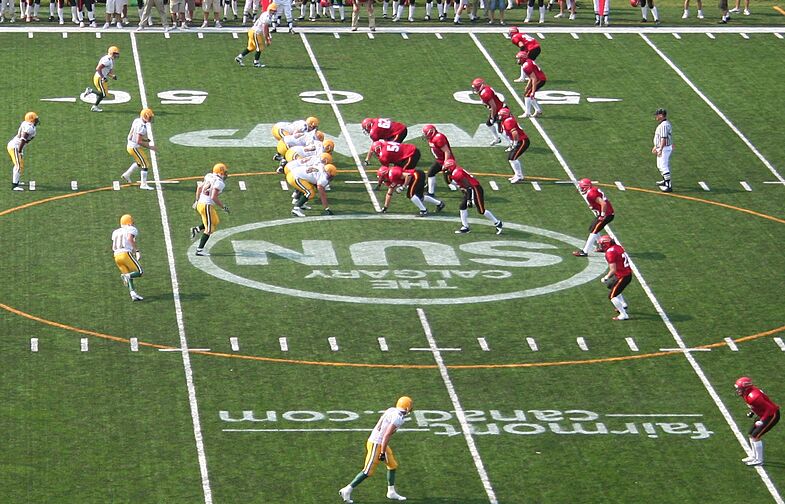Canadian football facts for kids
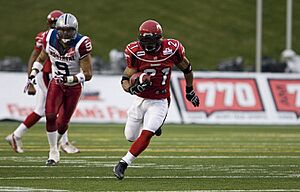
Calgary Stampeders (in red) vs. Montreal Alouettes game in 2007
|
|
| Nicknames | |
|---|---|
| First played | November 9, 1861 at University College, Toronto |
| Characteristics | |
| Contact | Full |
| Team members | 12 |
| Type |
|
| Equipment |
|
| Venue | Football field (150 yards (137 m) long and 65 yards (59 m) wide) |
| Glossary | Glossary of Canadian football |
| Presence | |
| Country or region | Canada |
| Olympic | No |
Canadian football, often just called football, is a popular sport in Canada. Two teams of 12 players each try to move an oval-shaped ball into the other team's end zone. The game is played on a field that is 110 yards (101 m) long and 65 yards (59 m) wide.
Canadian football and American football come from the same origins, but they have some key differences. In Canadian football, teams get three chances (called downs) to move the ball forward. The goalposts are at the front of the end zone. Each team has 12 players on the field. American football, on the other hand, uses four downs, has goalposts at the back of the end zone, and only 11 players per team. Canadian football fields are also bigger.
The sport grew from Rugby football in the early 1860s, brought to Canada by British people. The main professional league is the Canadian Football League (CFL). The Grey Cup, which is the CFL's championship game, is one of Canada's biggest sports events. Many people watch it on TV.
Canadian football is also played at many other levels. You can find it in high schools, at junior levels (for players aged 18–22 in the Canadian Junior Football League and Quebec Junior Football League), and in universities (called U Sports football, where teams play for the Vanier Cup). There are also semi-professional teams, like those in the Alberta Football League. If you want to learn more about the sport's history and famous players, you can visit the Canadian Football Hall of Fame in Hamilton, Ontario.
History of Canadian Football
The first recorded football game in Canada was a practice match on November 9, 1861, at University College, University of Toronto. Soon after, a football club was started at the university.
The first game with a written record happened on October 15, 1862, in Montreal. It was played between two army groups. In 1864, new rules based on rugby football were created at Trinity College in Toronto. Over time, the game became more popular. Famous clubs like the Hamilton Football Club (now the Hamilton Tiger-Cats) formed in 1869, and the Montreal Football Club in 1872. The Toronto Argonaut Football Club started in 1873, and the Ottawa Football Club (later the Ottawa Rough Riders) in 1876. Only the Toronto Argonauts are still playing continuously today.
In 1874, McGill University in Montreal played two games against Harvard University from the U.S. They used a mix of English rugby rules.
Over the years, different groups were formed to organize the sport. The Canadian Rugby Football Union started in 1880. Later, in 1956, the main professional leagues joined together to form the Canadian Football Council (CFC). In 1958, this group officially became the "Canadian Football League" (CFL).
Some rules changed over time to make Canadian football different from rugby and American football. For example, in 1903, teams were reduced to 12 players, and teams had to gain 10 yards in three downs. Forward passes were allowed in 1929, and touchdowns became worth six points in 1956. The main differences between Canadian and American football today come from rules that Americans changed but Canadians didn't. For example, both games used to have three downs and goalposts on the goal lines, but Americans changed these rules.
The Grey Cup was first awarded in 1909 by Albert Grey, 4th Earl Grey, who was Canada's Governor General. It was meant to be the championship for rugby football teams in Canada. At first, it was for amateur teams, but by the 1940s, professional teams started to dominate. When the last amateur team left the competition in 1954, it led to the modern professional Canadian football era and the creation of the CFL in 1958.
Canadian football is mostly played in Canada. The International Federation of American Football (IFAF) and Football Canada have agreed that Canadian amateur rules can be used for international friendly games.
-
A game between the 4th Canadian Armoured Division Atoms and First Canadian Army Red and Blue Bombers, in Utrecht, Netherlands, October 1945
-
Touchdown monument outside the Canadian Football Hall of Fame in Hamilton, Ontario
How Canadian Football is Played
Canadian football is played at many levels across Canada. The top league is the professional Canadian Football League (CFL), which has nine teams. The CFL season starts in June, and the playoffs for the Grey Cup finish by late November. In cities with outdoor stadiums, like Edmonton or Winnipeg, cold weather and icy fields can make games very exciting!
Amateur football is managed by Football Canada. At the university level, 27 teams play for the Vanier Cup. Junior football is for players who have finished high school but aren't in university yet. There are 19 junior teams competing for the Canadian Bowl.
Women's football has also become popular in Canada. The first women's league, the Maritime Women's Football League, started in 2004. The biggest women's league now is the Western Women's Canadian Football League.
The Field
A Canadian football field is 150 yards (137 m) long and 65 yards (59 m) wide. This includes two goal areas that are 20 yards (18 m) deep. The main playing area between the goal lines is 110 yards (101 m) long. At each goal line, there are tall goalposts that are 40-foot-high (12 m). They have a crossbar 18+1⁄2-foot-long (5.6 m) and 10 feet (3 m) above the ground.
The sides of the field are marked by white sidelines. White lines are drawn across the field every 5 yards (4.6 m). These are called "yard lines" and often show the distance to the nearest goal line. The middle line (55-yard line) is usually marked with a "C". "Hash marks" are painted parallel to the yard lines, 24 yards (21.9 m) from the sidelines in amateur games, and 28 yards (25.6 m) in the CFL.
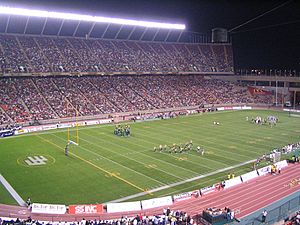
Sometimes, if a stadium has a running track around the field, the corners of the end zones might be cut off. This is to make space for the track.
How a Game Starts
At the start of a game, an official flips a coin. The visiting team's captain calls "heads" or "tails." The team that wins the coin toss decides whether to kick off or receive the ball first, or which side of the field they want to start on. The other team gets the remaining choice. Usually, teams choose to kick first in the first half and receive the ball in the second half.
Play begins with one team kicking the ball from their own 35-yard line (or 45-yard line in amateur games). Both teams try to catch the ball. The player who catches it can run with it or throw it sideways to a teammate.
When Play Stops
Play stops when:
- The player with the ball is tackled (their knee, elbow, or other body part touches the ground, not including hands or feet).
- A forward pass isn't caught.
- A touchdown or field goal is scored.
- The ball goes out of bounds.
- The player with the ball is standing but can't move forward anymore.
If no points were scored, the next play starts from a "scrimmage."
Scrimmage Play
Before a scrimmage, an official places the ball. This spot creates the "line of scrimmage," which is like a "no-man's land" that players can't cross until the play begins. The team with the ball (the offence) must have seven players near this line. The defending team (the defence) must stay at least one yard back.
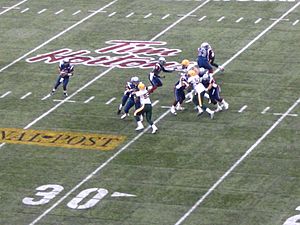
Each team has 12 players on the field. The offence starts the play by snapping the ball backwards through the legs of the centre to another player, usually the quarterback. Once the quarterback has the ball, they can:
- Run with the ball to gain yards.
- Pass the ball sideways or backwards to a teammate (a "lateral").
- Hand the ball off to a teammate, like a running back.
- Kick the ball (a "punt" or "place kick").
- Throw a "forward pass" to a receiver further down the field. Forward passes must be thrown from behind the line of scrimmage, and only one forward pass is allowed per play.
Each attempt to move the ball is called a "down." The offence gets three downs to move the ball at least ten yards forward. If they gain 10 yards, they get a new set of three downs. If they don't gain 10 yards in two downs, they usually punt the ball on third down or try a field goal. They can also try to gain the yards on third down, but if they fail, they lose possession of the ball.
How Teams Get the Ball
The ball changes possession in these ways:
- After a team scores a field goal, the other team can either start from their 35-yard line or have the scoring team kick off.
- After a touchdown, the scoring team kicks off from their own 35-yard line.
- If the defence scores a "safety" (tackling an offensive player in their own end zone), the defence gets to choose how play resumes.
- If one team kicks the ball, the other team can catch it and run with it.
- If the offence fails to gain 10 yards in three plays, the defence "takes over on downs."
- If the defence catches a forward pass thrown by the offence (an "interception"), the defence immediately gets possession.
- If a player drops the ball (a "fumble"), either team can pick it up.
- At halftime, the team that didn't kick off at the start of the game gets to receive the kickoff.
Rules for Contact
Only the player holding the ball (the ball carrier) can be legally tackled. On a passing play, defenders can't interfere with a receiver unless the receiver is within five yards of the line of scrimmage. Players can block others, but they can't hold or trip them. The quarterback can't be hit after throwing the ball, or hit below the knees or above the shoulders while behind the offensive line.
Penalties
Breaking the rules leads to "penalties," which usually mean losing 5, 10, or 15 yards.
- Small mistakes, like "offside" (a player crossing the line of scrimmage too early), are 5-yard penalties.
- More serious fouls, like "holding" (grabbing an opponent), are 10-yard penalties.
- Severe fouls, like "face-masking" (grabbing a player's helmet face mask), are 15-yard penalties.
Sometimes, a penalty against the defence can give the offence an automatic first down. If a penalty would move the ball more than half the distance to the goal line, the ball is moved half the distance instead, but never inside the 1-yard line.
Usually, the team that wasn't penalized can choose to "decline" the penalty. This means they ignore the penalty and the result of the play stands.
Kicking the Ball
Canadian football has four main ways to kick the ball:
- Punt: A player drops the ball and kicks it before it hits the ground. This is usually done on third down to give the ball to the other team far downfield.
- Place Kick: The ball is placed on the ground (or held by a teammate) and kicked. This is used for kickoffs, field goals, and extra points.
- Drop Kick: A player drops the ball and kicks it just as it bounces off the ground. This is very rare now.
On any kick, only the kicker and teammates who were behind the kicker when the ball was kicked can recover and advance the ball. Other players on the kicking team must stay at least five yards away from the ball until an opposing player touches it (this is called the "no-yards rule").
Scoring Points
Here's how teams score points:
- Touchdown (6 points): When a player carries the ball into the opponent's end zone, or catches a pass there. After a touchdown, the scoring team tries for an extra point.
- Convert (1 or 2 points): After a touchdown, the scoring team can try to kick the ball through the goalposts for 1 point (a "place kick") or run/pass the ball into the end zone again for 2 points.
- Field Goal (3 points): A place kick through the opponent's goalposts during regular play.
- Safety (2 points): When an offensive player with the ball is tackled in their own end zone, or the ball goes out of bounds from their own end zone. The defending team gets the points.
- Single (1 point): Also called a "rouge." This happens when a kicked ball (from a kickoff, punt, or missed field goal) goes into the opponent's end zone and then out of bounds, or the receiving team can't get the ball out of their end zone. The kicking team gets 1 point.
After a Score
- After a touchdown and convert, the scoring team kicks off from their 35-yard line.
- After a field goal, the team that was scored against can choose to either receive a kickoff or start from their own 35-yard line.
- After a safety, the scoring team can choose to receive a kickoff, kick off themselves, or start from their own 35-yard line.
- After a single, the team that was scored against starts from their own 35-yard line (or 40-yard line in the CFL).
Game Timing
A game has two 30-minute halves, each divided into two 15-minute quarters. The clock counts down from 15:00 in each quarter. There's a 2-minute break between quarters and a 15-minute break at halftime.
For most of the game, the clock stops when:
- Points are scored.
- The ball goes out of bounds.
- A forward pass is incomplete.
- There's a penalty.
- A player is injured.
- A team calls a time-out.
The clock starts again when the ball is ready for the next play.
In the last three minutes of each half, the clock stops every time the ball becomes dead. This makes the end of the game more exciting! If a quarter ends while the ball is still in play, the quarter continues until the play finishes.
Overtime
In the CFL, if a game is tied at the end of regular play, they go into overtime. Each team gets a chance to score from the opponent's 35-yard line. If one team scores a touchdown, they must try for a two-point conversion. If the score is still tied after both teams have had a chance, they keep playing until one team is ahead after an equal number of possessions. In the regular season, if it's still tied after two rounds of overtime, the game ends as a tie. In playoff games, they play until there's a winner.
Officials and Rules
Officials make sure the game rules are followed and manage the clock. They wear black-and-white striped shirts and carry a whistle. If they see a foul, they throw a weighted orange flag. There are seven officials on the field, each with different jobs:
- The referee is in charge of the game. They announce penalties and make final decisions on rules.
- The umpire watches the players on the line of scrimmage for fouls like holding.
- The back judge checks for legal catches and pass interference, and manages the play clock.
- The head linesman/down judge watches the line of scrimmage, rules on out-of-bounds plays, and works with the chain crew.
- The side judge helps the field judge and watches for fouls.
- The line judge watches player substitutions, the line of scrimmage during punts, and game timing.
- The field judge also watches the play clock and checks for fouls like offensive pass interference.
Another group of people, called the chain crew, helps measure for first downs. They use two large sticks with a 10-yard chain between them. They also have a "down marker" to show the current down. This system has been used for over 100 years and is very accurate.
Severe Weather
If there's lightning or other bad weather near the stadium, a CFL game must be delayed. In the regular season, if play can't start again after an hour and at least half of the third quarter is done, the game score becomes final. If the game is stopped earlier, or if it's a playoff or Grey Cup game, play can be stopped for up to 3 hours. After 3 hours, the game is stopped for the day. Playoff or Grey Cup games must continue the next day from where they left off.
Player Positions
|
The offence (yellow and white) are first-and-ten at their 54-yard line against the defence (red and black) in a U Sports football game. The twelve players of each side and the umpire (one of seven officials) are shown. The offence is in a one-back offence with five receivers. Note: The labels are clickable. |
Players in Canadian football have different jobs, or "positions," on the field. Here are some of the main ones:
Offensive Positions
The offence tries to score points. They must have at least seven players lined up on the line of scrimmage.
Offensive Linemen
These players protect the quarterback and help block for running plays. They usually don't run with the ball.
- Centre: Snaps the ball to the quarterback to start the play.
- Left/right guards: Stand next to the centre. They help protect the quarterback and block for runners.
- Left/right tackles: Stand at the ends of the offensive line. They are often the biggest players and are good at blocking passes.
Backs
These players are behind the linemen. They can run with the ball, receive handoffs, or catch passes.
- Quarterback: The leader of the offence. They get the ball from the snap and usually pass it, hand it off, or run with it.
- Fullback: Helps protect the passer, catches passes, and blocks for the running back. They sometimes run with the ball in short-yardage situations.
- Running back (or tailback): The main runner on the team. They also catch passes and block.
Receivers
Receivers catch passes. They can start on or behind the line of scrimmage.
- Wide receiver: Lines up wide on the line of scrimmage. They run routes to catch passes and gain yards.
- Slotback: Lines up behind the line of scrimmage, between the wide receiver and the tackle. They can start running before the snap and catch passes.
Defensive Positions
The defence tries to stop the offence from scoring. They must stay one yard behind the line of scrimmage until the play starts.
Defensive Linemen
These players try to get past the offensive line to tackle the quarterback or stop runners.
- Left/right defensive tackles: Try to break through the offensive line.
- Nose tackle: A defensive tackle who lines up directly across from the centre.
- Left/right defensive ends: The main players who rush the quarterback and try to stop runs behind the line of scrimmage.
Linebackers
Linebackers are behind the defensive line. They can rush the passer, stop runs, or cover receivers.
- Middle linebacker: Often the leader of the defence. They call plays for the linemen and other linebackers.
- Weak-side linebacker: Lines up on the shorter side of the field. They can cover passes or stop runs.
- Strong-side linebacker: Lines up on the longer side of the field. They usually focus on stopping the runner.
Defensive Backs
These players are in the back of the defence and mainly cover receivers.
- Cornerback: Covers one of the wide receivers.
- Defensive halfback: Covers one of the slotbacks and helps stop runs on their side of the field.
- Safety: Covers the deep part of the field and is the last line of defence. They sometimes rush the quarterback or stop runners.
Special Teams Positions
Special teams are used for kicking plays, like kickoffs, punts, and field goal attempts.
- Long snapper: Snaps the ball for punts, field goals, or extra points.
- Holder: Catches the snap and holds the ball for the kicker on field goal and extra point attempts.
- Kicker: Kicks kickoffs, field goals, and extra points.
- Punter: Kicks the ball (punts it), usually on third down.
- Returner: Catches kickoffs, punts, or missed field goals and tries to run the ball as far as possible. They are usually very fast.
See also
 In Spanish: Fútbol canadiense para niños
In Spanish: Fútbol canadiense para niños
- Comparison of American and Canadian football
- Glossary of Canadian football
- List of gridiron football teams in Canada
- American football
- Rugby football


